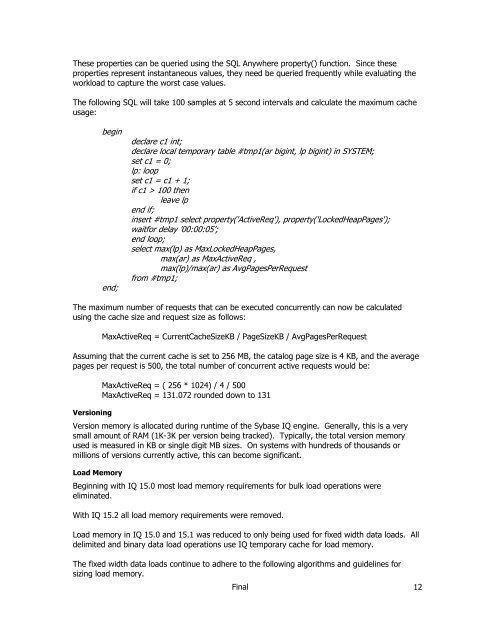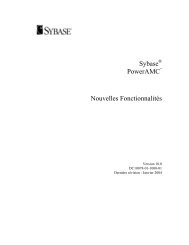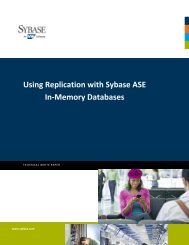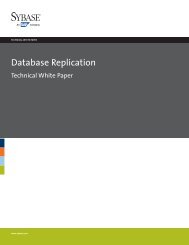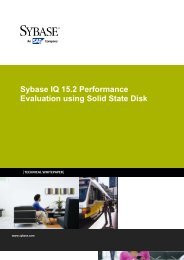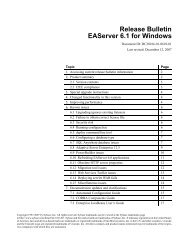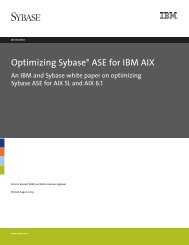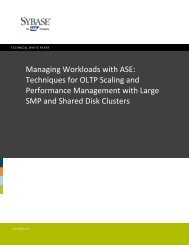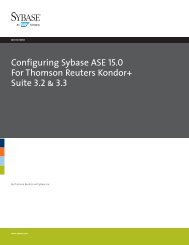A Practical Hardware Sizing Guide for Sybase IQ
A Practical Hardware Sizing Guide for Sybase IQ
A Practical Hardware Sizing Guide for Sybase IQ
You also want an ePaper? Increase the reach of your titles
YUMPU automatically turns print PDFs into web optimized ePapers that Google loves.
These properties can be queried using the SQL Anywhere property() function. Since these<br />
properties represent instantaneous values, they need be queried frequently while evaluating the<br />
workload to capture the worst case values.<br />
The following SQL will take 100 samples at 5 second intervals and calculate the maximum cache<br />
usage:<br />
begin<br />
end;<br />
declare c1 int;<br />
declare local temporary table #tmp1(ar bigint, lp bigint) in SYSTEM;<br />
set c1 = 0;<br />
lp: loop<br />
set c1 = c1 + 1;<br />
if c1 > 100 then<br />
leave lp<br />
end if;<br />
insert #tmp1 select property('ActiveReq'), property('LockedHeapPages');<br />
wait<strong>for</strong> delay ‟00:00:05‟;<br />
end loop;<br />
select max(lp) as MaxLockedHeapPages,<br />
max(ar) as MaxActiveReq ,<br />
max(lp)/max(ar) as AvgPagesPerRequest<br />
from #tmp1;<br />
The maximum number of requests that can be executed concurrently can now be calculated<br />
using the cache size and request size as follows:<br />
MaxActiveReq = CurrentCacheSizeKB / PageSizeKB / AvgPagesPerRequest<br />
Assuming that the current cache is set to 256 MB, the catalog page size is 4 KB, and the average<br />
pages per request is 500, the total number of concurrent active requests would be:<br />
Versioning<br />
MaxActiveReq = ( 256 * 1024) / 4 / 500<br />
MaxActiveReq = 131.072 rounded down to 131<br />
Version memory is allocated during runtime of the <strong>Sybase</strong> <strong>IQ</strong> engine. Generally, this is a very<br />
small amount of RAM (1K-3K per version being tracked). Typically, the total version memory<br />
used is measured in KB or single digit MB sizes. On systems with hundreds of thousands or<br />
millions of versions currently active, this can become significant.<br />
Load Memory<br />
Beginning with <strong>IQ</strong> 15.0 most load memory requirements <strong>for</strong> bulk load operations were<br />
eliminated.<br />
With <strong>IQ</strong> 15.2 all load memory requirements were removed.<br />
Load memory in <strong>IQ</strong> 15.0 and 15.1 was reduced to only being used <strong>for</strong> fixed width data loads. All<br />
delimited and binary data load operations use <strong>IQ</strong> temporary cache <strong>for</strong> load memory.<br />
The fixed width data loads continue to adhere to the following algorithms and guidelines <strong>for</strong><br />
sizing load memory.<br />
Final<br />
12


